
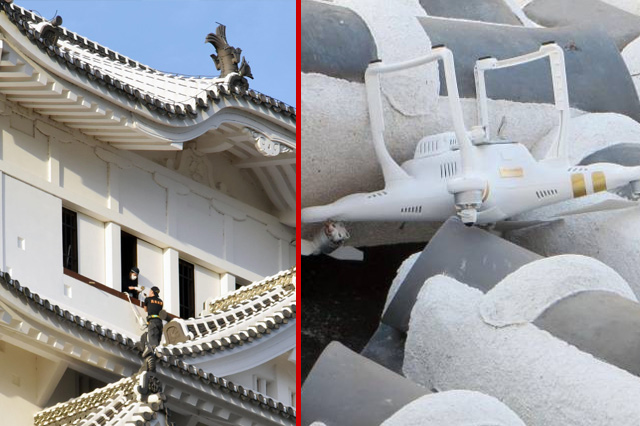
As sUAV/drones become more and more popular, it seems that more and more of them are striking the sides of buildings, trees, or poles without the pilot understanding why.
“It was flying fine and all of a sudden it zipped up and into the side of the building.” “Everything was great until the drone had a mind of its own and flew straight to the ground.”
“The drone was flying over the trees and all of a sudden it spun around and dropped into the trees.”
Reading forum conversations around the internet suggests this is a common, yet unfortunate and avoidable experience.
First, let’s establish that flying in GPS mode may be ineffective when very close to a building. Signal may be lost, and this could explain a few of the building strikes. Multipathing is a bear even if one is a highly experienced pilot and understands how to manage/mitigate multipathing.
However, far and away more likely in most instances the UAV was caught in a “rotor.” These are also known as up/down drafts, lee waves, or cross-winds, depending on which aviation discipline one adheres to. Needless to say, these phenomenon do exist, and play havoc with any sort of aerial activity whether it’s wingsuiting, parasailing, skydiving, model aircraft flight, swooping, small aircraft, and particularly light-weight multirotors.

THESE “WAVES” ARE INDICATORS FOR MANNED AVIATION AND CONSTRUCTION CREWS, YET THE PRINCIPLE IS
ONLY A MATTER OF SCALE.
Even when a manufacturer provides a statement of stability in “X” winds, this should not fool a pilot into thinking that the sUAS is turbulence-resistant. Given enough turbulence or infrequency of a wave, the UAV will become unstable.
It’s always better to be down here wishing we were up there, instead of being up there wishing we were down here.
Old Skydiver saying…
The first rule is to set wind limits. Small quad-craft should stay on the ground at windspeeds of greater than 12mph/5.5 meters per second. Hexcopters should consider grounding themselves at 22mph/10meters per second. Of course, this figure may vary depending on your organizations policy and procedures manual, insurance requirements, or payload on the sUAS.
This video provides some demonstration of the cycle of the wave and how a gyro and accelerometer might cope with the cycles. Notice how all the aircraft are “cycling” in an attempt to maintain altitude and position, even as the waves of the wind rotate?
Truly, knowing about them is half the battle. Staying away from them is the rest of it. Failing the former, being able to manage the craft in turbulence is the next-best step.
A building blocks the wind on one side (windward side) and on the opposite side (leeward side) the wind will pay all sorts of havoc with any flying object. Winds will extend in distance up to four times the height of the obstacle, and two times the actual height.
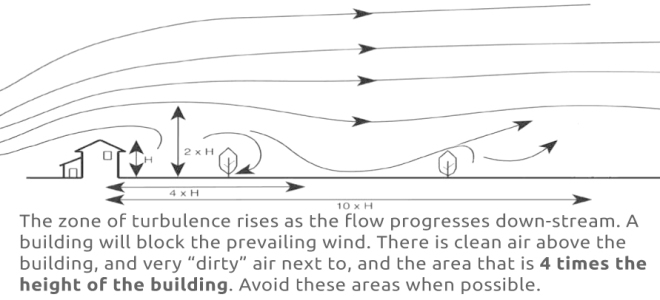
40×4=160 feet. Therefore, for 160’ beyond the obstacle at ground level, your multirotor is at risk for catching either a down draft or an updraft.
Huh?
OK, say there is a building that is 40 feet in height, and you have a medium wind blowing. Gusting or steady, it makes no difference.
40×4=160 feet. Therefore, for 160’ beyond the obstacle at ground level, your multirotor is at risk for catching either a down draft or an updraft. Either way, the airframe/hull is not in clean air. In extremely high velocities (high winds) the ratio of obstacle/distance may be as great as 15X (of course, a UAS would likely not fly in these winds)!
In terms of height, depending on wind velocity, the UAV may have to climb as high as 80’ to find clean air above an obstacle. yet at 80′ AGL, the winds are likely entirely different as well, depending on the weather and other obstacles in the area.
The air goes over the obstacle and is “pulled” to the ground (downdraft), where it then “bounces” upward (updraft) and tries to resume its level flow.
These phenomena are entirely independent of sinks,thermal rises, dust devils, and the like.
This also occurs in natural/unbuilt up areas. Trees, canyons, ridges, rock-lines; any large object will incur rotors. Avoid them. It’s virtually impossible to determine exactly where the down draft vs. the updraft may be occurring, and the location of these dirty winds will change with swind velocity.
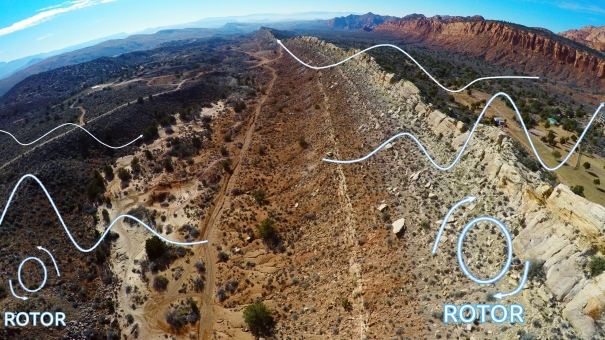
FLYING IN URBAN ENVIRONMENTS
When wind flows between buildings, the mass of the air/gas is compressed. This results in an increase in velocity. Think of squeezing hard on a tube of toothpaste, compressing the contents through the tiny hole in the end of the tube. This increases the speed/velocity at which the toothpaste squeezes out. The same thing occurs with moving air between buildings or other solid objects.
Depending on the wind speed, the increase may require as much as 4-10 times the distance before the winds return to “normal” velocity seen before the gap or corner.
Ground winds and winds “aloft” (true winds aloft are beyond the reach of most UAS operations) are rarely equal. Winds at 50′ are rarely the same as winds at ground level in an urban or suburban environment. Even small berms in the ground can cause jarring turbulence (as shown above) that settle in the low areas. These urban “microclimates” can be very problematic for light weight UAS in required-precision environments.
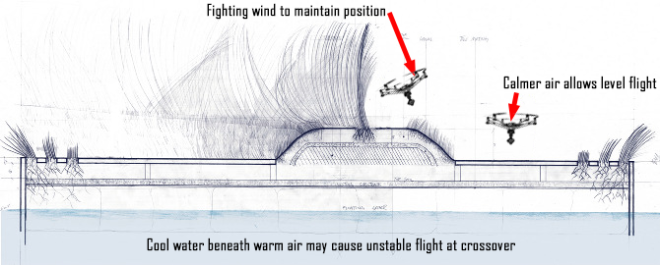
Here is a more complex example of winds blowing at 22mph in an urban environment.
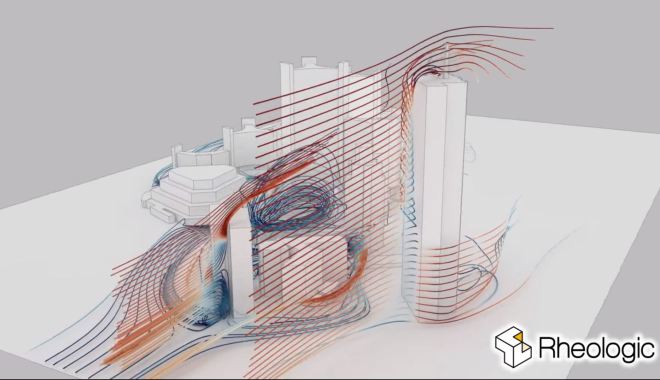
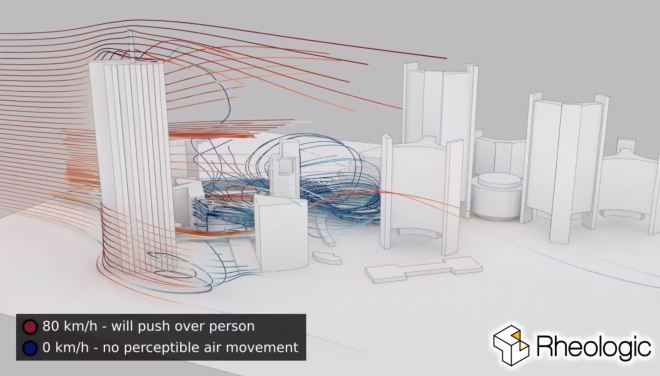
Compression of the flow due to building dynamics push the wind into more than 40mph in some areas. While the overall winds, and reported winds in the area suggest that the windspeed is perfectly acceptable for most commercial aircraft, turbulence and accelerated velocities within tight areas are far beyond the risk limits of most small UAS’.
Flying from warm sands to flying over water on a hot summer day may also create challenges to smooth and level flight.
DUST DEVILS


Dust devils are summertime phenomena that can be very dangerous to humans anywhere a UAS may be flying. If they happen in a city, there is usually ample evidence of their existence, as debris flies high in the “funnel.” These nasty actors can show up anywhere there is hot asphalt, sand, dirt, and if that mass of rapidly moving air connects with a cool surface, they can turn violent very quickly, slinging a sUAS far from its intended flight path.
DUST DEVILS IN THE NEVADA DESERT CAN BE FRIGHTENING, ESPECIALLY WHEN TWO OR THREE COMBINE INTO ONE VORTEX.
If by chance a dust devil is seen climbing in the distance, prepare to bring the aircraft home and land. If the dust devil is anywhere near the vehicle, climb in altitude while moving in any direction away from the dust devil. They are usually very short-lived.
IMAGE COURTESY WASHINGTON POST

How do we avoid getting caught in turbulent air? The long answer is “experience.” Flying in these challenging spaces teaches us to find the lee, based on the behavior of the UAS, which will always be slightly latent to the wind.
The short answer is to study environments. Look at the wind indicators that might normally be missed. Learn to read the environment; it’s not hard once one begins to look for the details around buildings, trees, brush, monuments, chimneys, and other ground obstacles.
Two standard practices that may help save pilots from troubles;
- Use a windmeter/anemometer, and check the winds frequently in midday flights.
- Have a corporate or personal policy of a hard-deck/stop speed. This eliminates wishy-washy/should I/shouldn’t I decisions in the field. Our cap for teaching students with a Hexcopter/Yuneec Typhoon H is 16mph. If a gust crosses 16, we stop and wait it out to determine the wind trendline.
Another practice (although not standard) is to put a 5′ stream of crepe’ paper on a stick at eye level or so. This WDI, or Wind Direction Indicator, will immediately demonstrate changes in windspeed or direction, both clues that the weather may be rapidly shifting.
Determine distances from obstacles as accurately as possible prior to flight in order to best understand where the rotors will occur. Doing so goes a long way to maintaining control and safety when the drone is in flight. With a bit of experience, one rarely needs to worry about obstacle turbulence.
Leave a Reply